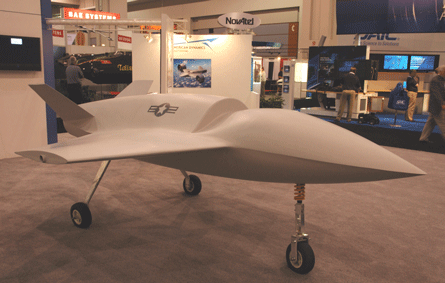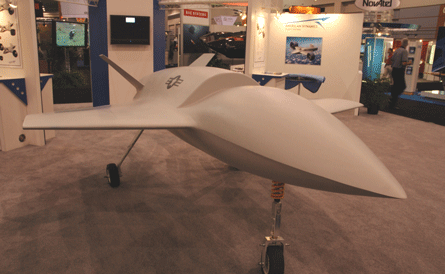American Dynamics has unveiled plans for an evolved tactical version of its BattleHog 100x vertical take-off and landing unmanned air vehicle as a potential contender for emerging US Navy and Marine Corps Tier III requirements.
The new UAV, designated the AD-150, would feature twin gimballed lift fans mounted on the wingtips, with these driven by a turboshaft engine. It would feature a highly streamlined fuselage with low observable features, including an overhead intake for the engine.
 |
|---|
A full-scale model of the air vehicle configuration was displayed for the first time at the Association for Unmanned Vehicle Systems International's Unmanned Systems North America exhibition in Washington on 7 August.
The type would be all composite, with a span of 5.3m (17.5ft) and a length of 4.4m.
American Dynamics executive Stefan Amraly says design work began last year with a third-party computational fluid design analysis conducted to validate its characteristics.
 |
|---|
He says development lead times are being correlated to potential US military programmes such as the USN Tier III schedule, but with ongoing testing of the core lift system and fight-control technologies being carried out using the BattleHog 100x demonstrator, a UAV that was unveiled in August 2006.
BattleHog development is continuing, with tethered flights being carried out to map the characteristics of American Dynamics' patented high torque aerial lift (HTAL) system. Free flight of the demonstrator is in planning says Amraly: "We need to do this safely."
The two podded HTAL fans on the AD-150 version will be independently steerable. The proposed production standard system would use a powerplant of the Pratt & Whitney Canada PW207 class, and have a maximum speed of around 300kt (555km/h). Maximum take-off weight is planned at 1,020kg (2,250lb) with a payload of 225kg.
Preliminary design work on an unmanned combat air vehicle derivative of the BattleHog family proposed by American Dynamics last year is also continuing, but with much longer lead times than those in the AD-150 development plan. "The UCAV is about five years out," says Amraly.
Development funding for the new-generation UAVs continues to be provided by private investors, Amraly says. The company is now based at a new facility at Calverton in New York state. The site was formally owned by Northrop Grumman and was used to support manufacture of Grumman F-14 fighters and E-2C Hawkeye airborne early warning aircraft.
Source: Flight International



















